Key Point
- There are 43000 species of spiders worldwide, known to humans.
- The process of spinning a spider web has amazed even scientists across the world.
- Usually spiders use their poison and venom to incapacitate their prey.
- Spiders are mostly scared of humans and only populate areas where humans don’t visit often.
Spiders have acquired an unfair reputation as deadly predators. Out of some 43,000 known species worldwide, only about 30 of them are regularly responsible for human deaths. The toxin is primarily evolved for subduing smaller prey and rarely has an effect on humans. And even when the toxin does produce serious side effects, anti-venom and medication are almost always effective at treating it. However, it’s estimated that four people die from spider bites every year in the United States alone. This article will cover some interesting facts about the top 8 deadliest and most dangerous spiders in North America, as measured by the potency of their bite and the severity of the symptoms.
It’s important to note that there’s a difference between venomous and poisonous spiders. Venomous spiders can produce and directly deliver their own toxins through their fangs, while poisonous spiders contain toxins in their tissue, which is dangerous to any creature that ingests it. This poisonous substance is sometimes acquired from the environment or their diet rather than produced directly. All of the spiders on this list generally deliver venom through their fangs.
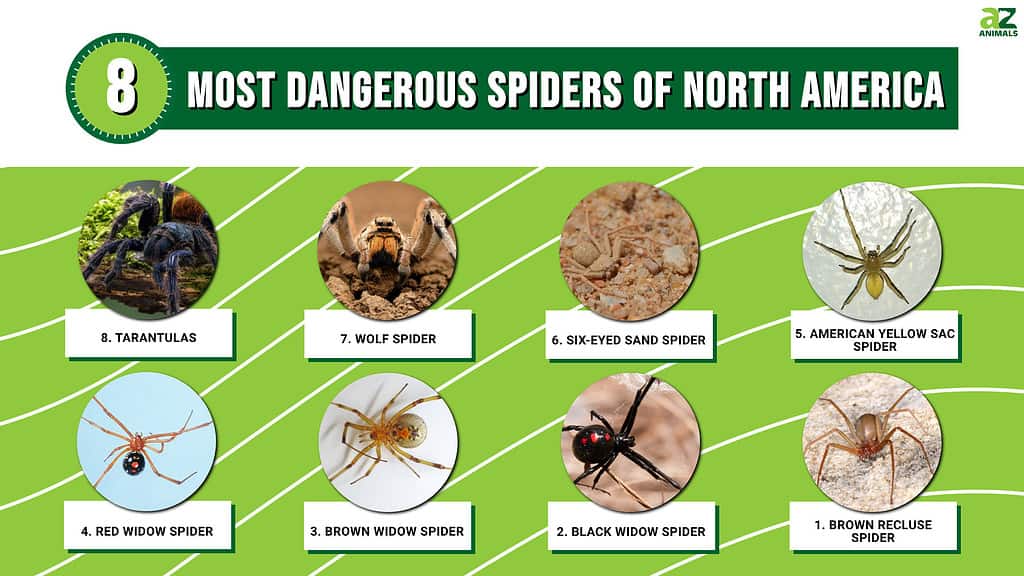
#8: Tarantulas
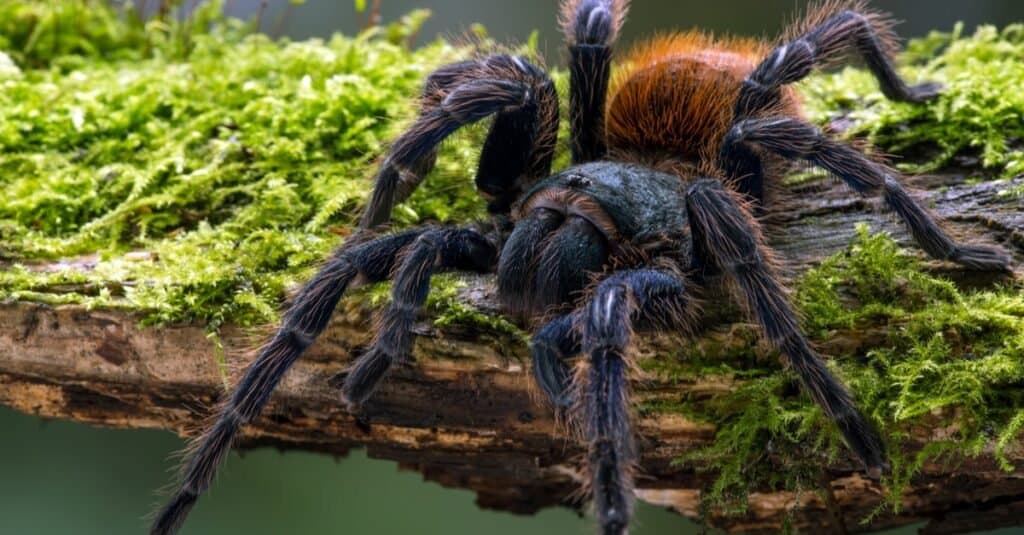
©davemhuntphotography/Shutterstock.com
The big, intimidating tarantula, which preys upon insects, small lizards, and even other spiders, thrives in habitats as diverse as dry and arid deserts, rugged mountains, and rainforests. But don’t let its size fool you. While its bite can produce a very painful sting, the venom has surprisingly little toxicity to humans. It will normally cause pain and swelling on par with a bee sting (though some people may have a more serious reaction). Unfortunately, its prey isn’t so lucky; their insides are gradually liquefied by the venom. The tarantula also has urticating” hairs that can penetrate the skin, resulting in pain and irritation.
Tarantulas enjoy warmer climate and surprisingly, you cannot find a tarantula in the Antarctica. Tarantulas are nocturnal creatures and hunt in the dark. Tarantulas have exoskeleton that they shed as they grow. The Tarantula mating is fraught with danger as the male tarantula has to hold back the fangs of the female with the spurs on their front legs. Due to over-collection for pet trade, the tarantula are now an endangered species and have ended up in the Convention on International Trade in Endangered Species (CITES) list.
#7: Wolf Spider

©Cornel Constantin/Shutterstock.com
The wolf spider earned its name from the highly developed predatory instincts. Once it has spotted a suitable prey, the wolf spider will pursue its quarry and pounce on it like the carnivorous animal for which it’s named. There are some 125 species found in North America alone, reaching as far north as the Arctic. They can be found hiding within the grass, stones, logs, leaves, and even manmade buildings, constructing a silk-lined nest within the ground. One of the most interesting facts is that the young spiders will hitch a ride on the mother’s back until they’re old enough to survive on their own. The large egg sac attached to the female’s abdomen can also aid with identification.
Like many other species in this article, the wolf spider is not particularly aggressive toward humans; it would much prefer to ignore people than interact with them. But it will sometimes bite people out of self-defense. While the venom isn’t too dangerous (except for people with allergic reactions, who may suffer from nausea, dizziness, and elevated heart rate), the real damage actually comes from the large and powerful fangs. They can cause a significant amount of swelling and redness at the location of the bite. Some people have likened it to the sensation of a bee sting.
You can read more about the wolf spider here.
#6: Six-Eyed Sand Spider
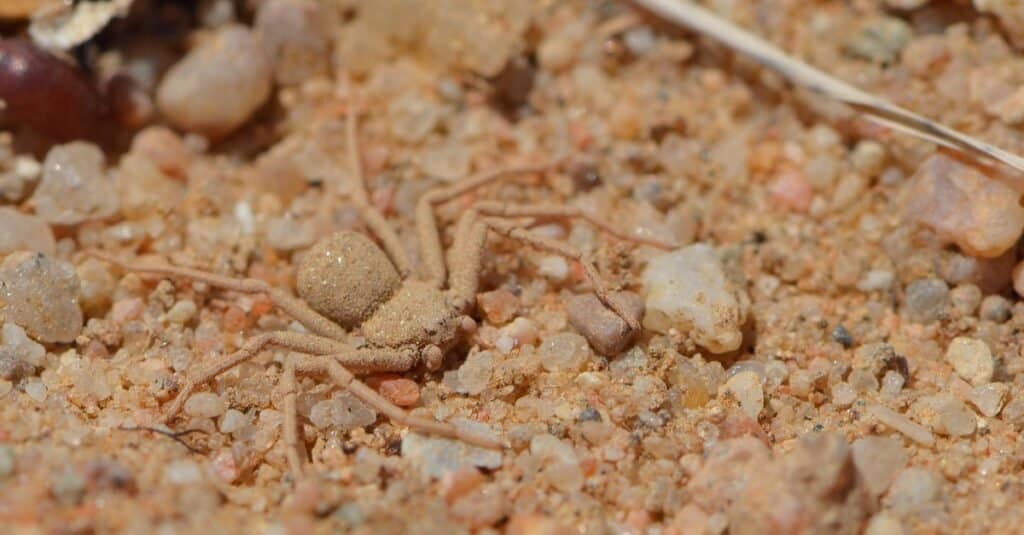
©Tobias Hauke/Shutterstock.com
The six-eyed sand spider (also known as Sicarius, which means assassin in Latin) is a large, gray-colored spider (measuring 1 or 2 inches long) that buries itself in the sand and waits for prey to pass by. While most species are native to South America, there is a single species that can be found in sandy habitats of El Salvador, Nicaragua, and Costa Rica. As the name suggests, the six eyes, rather than the usual eight, are key to its identification. Its closest living relative is the recluse spider (about which more will be said later). While it seldom comes into contact with people and very rarely bites, studies have shown that its venom could potentially cause severe bleeding and tissue damage. No anti-venom exists for this species.
#5: American Yellow Sac Spider

©Austin Campbell / Creative Commons – License
The yellow sac spider is among the most common types of spiders found in Eurasia and Africa. There are more than 200 documented species, but this is the only one entirely native to North America, the Caribbean, and downward through South America. The American yellow sac spider likes to build silken tubes in stones, leaves, grasses, trees, or manmade structures. Measuring about an inch long with the legs included, this species has a pale yellow or beige body with dark brown markings around the jaws and feet to aid in identification. The front pair of legs tend to be a lot longer than the other three.
Yellow sac spiders will sometimes bite people in defense of their eggs. The dangerous venom (called a cytotoxin) has the ability to destroy cells or impair their function. Localized redness, swelling, itching, and pain around the injection site are the most common symptoms. Rarely, skin lesions may form around the bite as well, resulting in tissue death, making it one of the most dangerous spiders. Symptoms usually resolve within seven to 10 days without too many long-term complications, but in the meantime, it is not a pleasant experience to go through.
You can read more about the yellow sac spider here.
#4: Red Widow Spider

©Florida Division of Plant Industry Archive / CC BY 3.0 US, via Wikimedia Commons – License
A close relative of the better known black widow, this species can be identified by the orange-red colors of the upper body and the lower black abdomen with bright red spots and markings (which can take the shape of an hourglass, a triangle, or something far more indistinct). The long and sinewy legs of the female can reach up to 2 inches in size, while the male is less than an inch long. Their natural range is fairly limited to the palmetto scrubland and sand dune habitats of central and south Florida, so most people will never even encounter them, but there is some evidence to suggest that it might be expanding its range further north as well.
While not generally aggressive, the red widow has been known to bite people in defense of its eggs or itself. Common symptoms include pain, cramping, nausea, and sweating. The only reason the red widow isn’t ranked higher on the list is that the potent venom is only delivered in small amounts, but it but could potentially threaten children, the elderly, and people with heart problems, making it one of the most dangerous spiders.
#3: Brown Widow Spider

.
©Decha Thapanya/Shutterstock.com
The brown widow spider is among the most dangerous spiders in North America. It actually first evolved in Africa and then spread throughout many other parts of the globe, including southern California and the Gulf Coast states. It is identified by the brown body, long legs, and orange or red markings on the abdomen. While the venom is twice as potent as the black widow, it only injects a small amount of venom at once and isn’t particularly aggressive. This means, as a whole, it’s actually considered to be less dangerous. Most of the symptoms occur around the bite area. However, the potent neurotoxin can disrupt nerve endings to cause pain, sweating, vomiting, and muscle rigidity.
#2: Black Widow Spiders
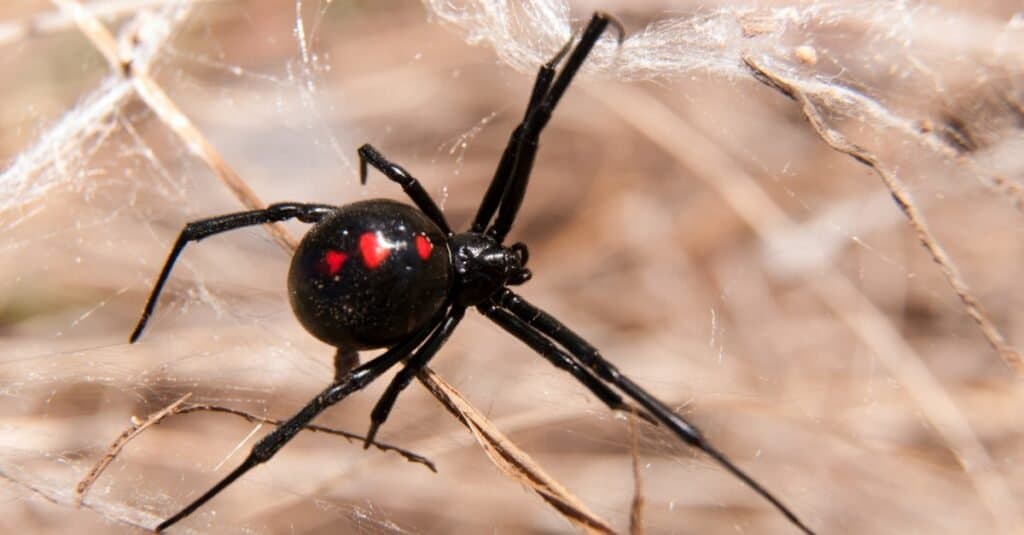
©Sari ONeal/Shutterstock.com
No list of dangerous spiders in North America would be complete without the iconic black widow. It is actually divided into a few different species, including the northern black widow, the western black widow, and the southern black widow. The female members of this species, which can be identified by the black body and red hourglass markings on the abdomen, measures about 1 or 2 inches long with legs extended, though the males measure significantly less. They also have particularly large venom glands compared to body size. This very potent neurotoxin can cause severe pain, abdominal cramping, nausea, sweating, and a fast heart rate, making it one of the most dangerous spiders. Fortunately, black widows almost never bite people unless they feel threatened or provoked. They will often deliver a dry bite rather than a venomous one. And even if they do deliver venom, the bite is very rarely fatal. But the sheer potency and quantity of their venom rank them among the deadliest spiders in the world.
You can read more about the black widow spider here.
#1: Brown Recluse Spider
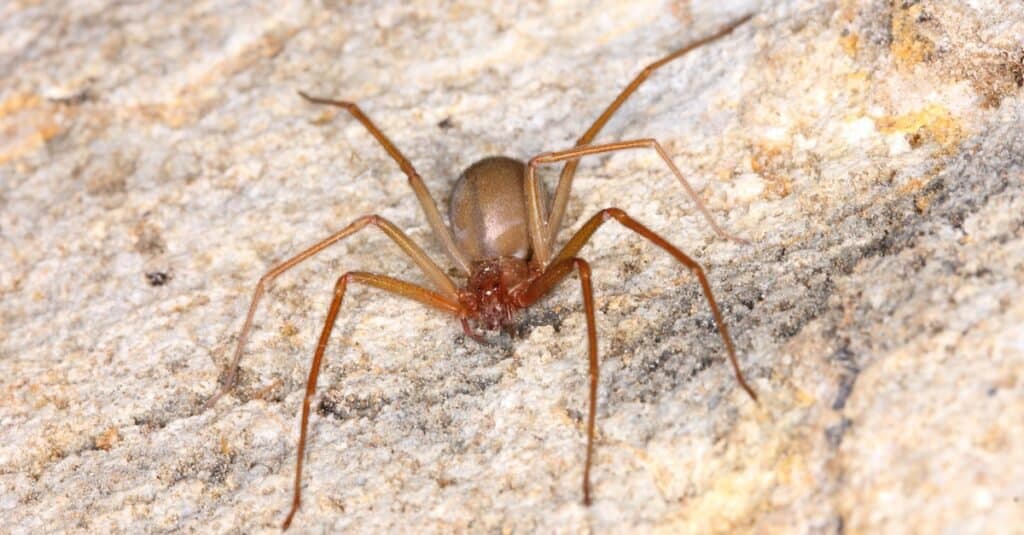
©Pong Wira/Shutterstock.com
Native to the central and eastern part of the United States, the brown recluse spider is perhaps the deadliest species in all of North America. It can be identified by the brown or gray body, the violin-shaped markings, the long legs, and the three pairs of eyes (compared to most spiders with four pairs). One of the most interesting facts is that the brown recluse spider can self-amputate a limb to flee from a predator or prevent the venom from spreading to the rest of the body. It doesn’t regrow the limb, however, and simply compensates for the loss with an uneven gait.
While they’re not very aggressive, and most bites don’t cause major symptoms, the venom can lead to serious complications in a minority of cases, including the possibility of skin necrosis, nausea, vomiting, fever, rashes, and muscle and joint pain. In very rare cases the venom of the brown recluse can lead to organ damage and eventual death. The Chilean recluse spider, an accidental import from Chile, is perhaps even deadlier.
Summary
Here is our list of the most dangerous spiders on the planet:
| Rank | Spiders |
|---|---|
| 1 | Brown Recluse Spider |
| 2 | Black Widow Spiders |
| 3 | Brown Widow Spider |
| 4 | Red Widow Spider |
| 5 | American Yellow Sac Spider |
| 6 | Six-Eyed Sand Spider |
| 7 | Wolf Spider |
| 8 | Tarantulas |
Bonus: Dangerous Spiders
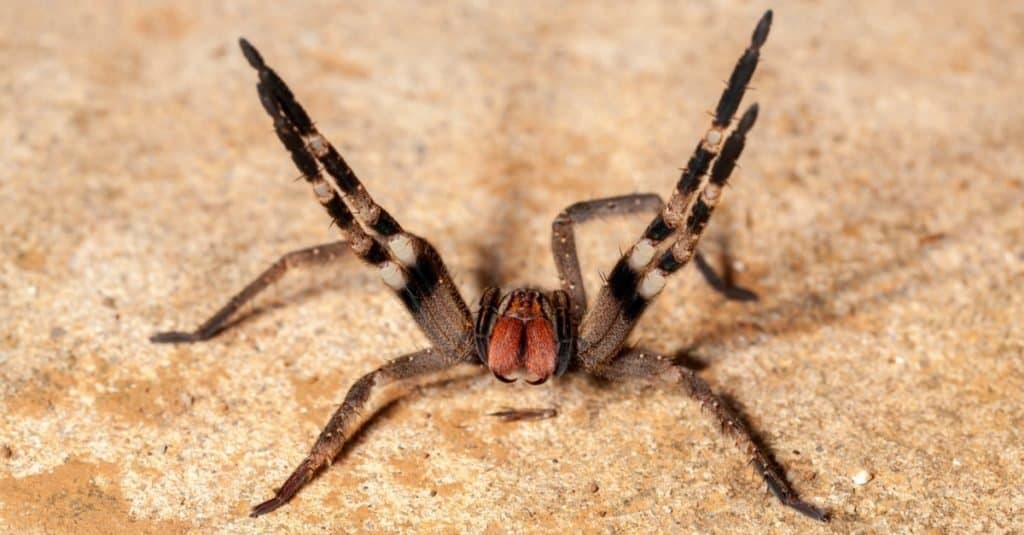
The Brazilian Wandering Spider is called “armed spiders” in Portuguese because their venom is a powerful weapon.
©Tacio Philip Sansonovski/Shutterstock.com
Here are some bonus dangerous spiders that are found worldwide:
- Brazilian wandering spider
- Chilean recluse spider
- Sicarius
Brazilian wandering spiders, when they bite, can induce severe symptoms such as heightened pulse, elevated blood pressure, and rapid respiratory rate, along with intense pain.
Additionally, the Chilean recluse spider is known to be one of the most venomous species among the Loxosceles genus, which possesses necrotizing venom. It has been linked to a handful of fatalities in South America.
The biggest and most assertive spiders within the Sicarius genus can be found in Chile. These spiders are venomous and primarily hunt insects, with occasional instances of targeting vertebrates.
The photo featured at the top of this post is © Vladimira Pufflerova/Shutterstock.com
Thank you for reading! Have some feedback for us? Contact the AZ Animals editorial team.






